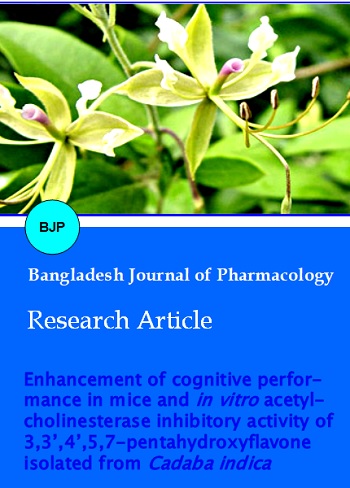Enhancement of cognitive performance in mice and in vitro acetylcholinesterase inhibitory activity of 3,3,4,5,7-pentahydroxyflavone isolated from Cadaba indica
DOI:
https://doi.org/10.3329/bjp.v11i4.28000Keywords:
Acetylcholinesterase, Cadaba indica, Cognitive performance, Mice, PentahydroxyflavoneAbstract
Cadaba indica, a component of traditional siddha medicine, is used for the therapy of gonorrhea, inflammation, eczema etc. The present study shows that it exhibited acetylcholinesterase inhibitory activity (up to 81.5 ± 1.5%) at the concentration of 3 mg/mL, with the IC50 value of 1.8 mg/mL. Furthermore, the ethanol extract of C. indica therapy at a dose of 100 mg/kg p.o significantly ameliorated the cognitive impaired mice in Y-maze task. The active ingredient was identified as 3,3,4,5,7-pentahydroxyflavone. The above results suggest that C. indica would be a potential natural therapeutic remedy for cognitive disorders mediated by cholinergic dysfunction.
Video Clip of Methodology:
Memory impairment test in mice: 1 min Full Screen Alternative
Downloads
147
124 Read
18

Published
How to Cite
Issue
Section
License
Authors who publish with this journal agree to the following terms:
- Authors retain copyright and grant the journal right of first publication with the work simultaneously licensed under a Creative Commons Attribution License that allows others to share the work with an acknowledgement of the work's authorship and initial publication in this journal.
- Authors are able to enter into separate, additional contractual arrangements for the non-exclusive distribution of the journal's published version of the work (e.g., post it to an institutional repository or publish it in a book), with an acknowledgement of its initial publication in this journal.
- Authors are permitted and encouraged to post their work online (e.g., in institutional repositories or on their website) prior to and during the submission process, as it can lead to productive exchanges, as well as earlier and greater citation of published work (See The Effect of Open Access).
